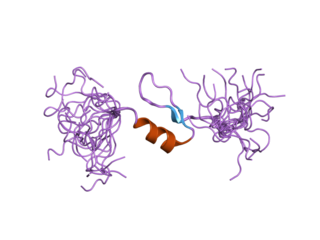An insulator is a type of cis-regulatory element known as a long-range regulatory element. Found in multicellular eukaryotes and working over distances from the promoter element of the target gene, an insulator is typically 300 bp to 2000 bp in length. Insulators contain clustered binding sites for sequence specific DNA-binding proteins and mediate intra- and inter-chromosomal interactions.

GATA-binding factor 1 or GATA-1 is the founding member of the GATA family of transcription factors. This protein is widely expressed throughout vertebrate species. In humans and mice, it is encoded by the GATA1 and Gata1 genes, respectively. These genes are located on the X chromosome in both species.
In molecular genetics, the Krüppel-like family of transcription factors (KLFs) are a set of eukaryotic C2H2 zinc finger DNA-binding proteins that regulate gene expression. This family has been expanded to also include the Sp transcription factor and related proteins, forming the Sp/KLF family.
A locus control region (LCR) is a long-range cis-regulatory element that enhances expression of linked genes at distal chromatin sites. It functions in a copy number-dependent manner and is tissue-specific, as seen in the selective expression of β-globin genes in erythroid cells. Expression levels of genes can be modified by the LCR and gene-proximal elements, such as promoters, enhancers, and silencers. The LCR functions by recruiting chromatin-modifying, coactivator, and transcription complexes. Its sequence is conserved in many vertebrates, and conservation of specific sites may suggest importance in function. It has been compared to a super-enhancer as both perform long-range cis regulation via recruitment of the transcription complex.
The human β-globin locus is composed of five genes located on a short region of chromosome 11, responsible for the creation of the beta parts of the oxygen transport protein Haemoglobin. This locus contains not only the beta globin gene but also delta, gamma-A, gamma-G, and epsilon globin. Expression of all of these genes is controlled by single locus control region (LCR), and the genes are differentially expressed throughout development.

Homeobox protein Hox-A9 is a protein that in humans is encoded by the HOXA9 gene.

Krueppel-like factor 6 is a protein that in humans is encoded by the KLF6 gene.

Krüppel-like Factor 2 (KLF2), also known as lung Krüppel-like Factor (LKLF), is a protein that in humans is encoded by the KLF2 gene on chromosome 19. It is in the Krüppel-like factor family of zinc finger transcription factors, and it has been implicated in a variety of biochemical processes in the human body, including lung development, embryonic erythropoiesis, epithelial integrity, T-cell viability, and adipogenesis.

Alpha-globin transcription factor CP2 is a protein that in humans is encoded by the TFCP2 gene.

Transcription factor NF-E2 45 kDa subunit is a protein that in humans is encoded by the NFE2 gene.

Krueppel-like factor 11 is a protein that in humans is encoded by the KLF11 gene.

Kruppel-like factor 13, also known as KLF13, is a protein that in humans is encoded by the KLF13 gene.

Transcription factor MafK is a bZip Maf transcription factor protein that in humans is encoded by the MAFK gene.

Krueppel-like factor 9 is a protein that in humans is encoded by the KLF9 gene. Previously known as Basic Transcription Element Binding Protein 1, Klf9 is part of the Sp1 C2H2-type zinc finger family of transcription factors. Several previous studies showed Klf9-related regulation of animal development, including cell differentiation of B cells, keratinocytes, and neurons. Klf9 is also a key transcriptional regulator for uterine endometrial cell proliferation, adhesion, and differentiation, all factors that are essential during the process of pregnancy and are turned off during tumorigenesis.

Krueppel-like factor 8 is a protein that in humans is encoded by the KLF8 gene. KLF8 belongs to the family of KLF protein. KLF8 is activated by KLF1 along with KLF3 while KLF3 represses KLF8.

Hemoglobin subunit theta-1 is a protein that in humans is encoded by the HBQ1 gene.

Krüppel-like factor 3 is a protein that in humans is encoded by the KLF3 gene.

Krueppel-like factor 17 is a protein that in humans is encoded by the KLF17 gene.

Krüppel-like factor 15 is a protein that in humans is encoded by the KLF15 gene in the Krüppel-like factor family. Its former designation KKLF stands for kidney-enriched Krüppel-like factor.

Chromatin target of PRMT1 is a protein that in humans is encoded by the CHTOP gene.



















